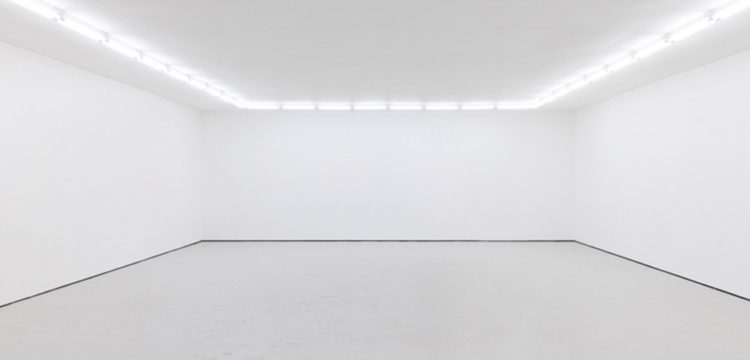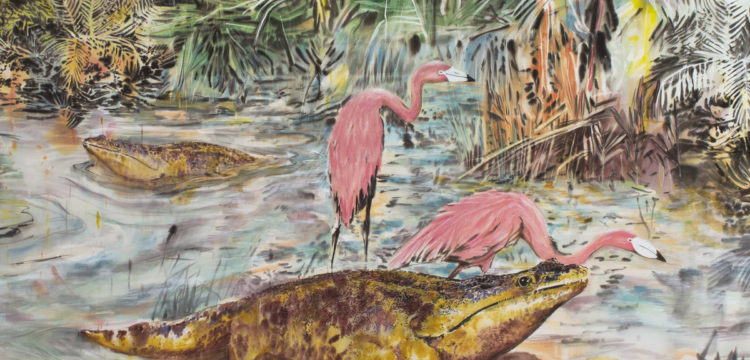Memories to Posterity
Simon Würsten talked to Niels Trannois about his artistic practice and the importance of memory and knowledge transfer
French born and Switzerland based artist Niels Trannois is currently presenting a new site-specific installation as part of Hunter of Worlds, a group exhibition curated by Elise Lammer at SALTS, Basel. The show draws inspiration from the eponymous novel by American science fiction writer C. J. Cherryh (1977), that tells a story of invasion, exploitation and cultural domination in a remote future. Besides Niels Trannois’s installation, Hunter of Worlds features works by Nina Canell, Rochelle Feinstein, Louise Lawler, Marie Matusz, Josep Maynou, Alan Schmalz and John Smith, and invites the viewer to look at the artworks as if they were the physical remnants of a disappeared civilization, thus questioning notions of language, symbolism and transmission of meaning beyond finite time and space.
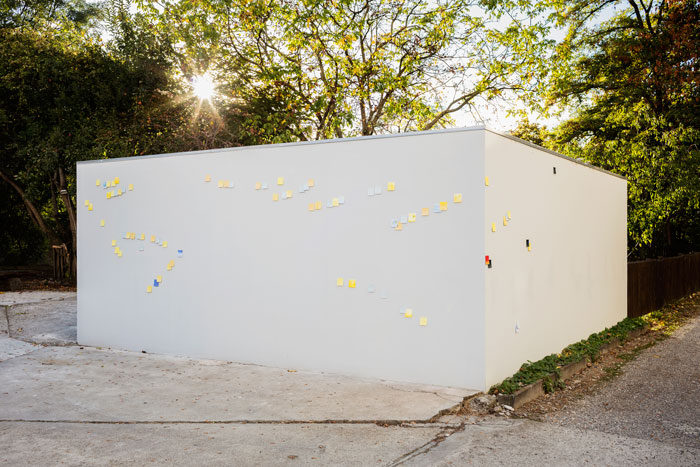
Niels Trannois, La Mue (Singe est nu), 2017-18. All photographs © SALTS and Gunnar Meier, 2018
Simon Würsten: To begin with, could you describe the installation you are presenting in Basel and tell me more about what inspired you to choose such a presentation format?
Niels Trannois: La Mue (Singe est nu) is a site-specific wall installation that I realized for the exhibition at SALTS. It is composed of 120 sheets of porcelain, all in the same post-it note format, engraved and glazed. It partly takes up elements that I had already presented in a former wall installation for the exhibition Alpina Huus at Le Commun in Geneva, in December 2017. Back then, I had two main sources of inspiration for this work: Marguerite Duras’s short film Les mains négatives (1978) and the frescoes of Palazzo Massimo alle Terme in Rome. I no longer had a studio to produce, and that’s how I decided to make a wall installation composed of a multiplicity of small elements. Palazzo Massimo’s frescoes are located in the vestibule, and what inspired me was the possibility of exploiting this idea of a hallway, as a space of transition between the public and the private spheres.
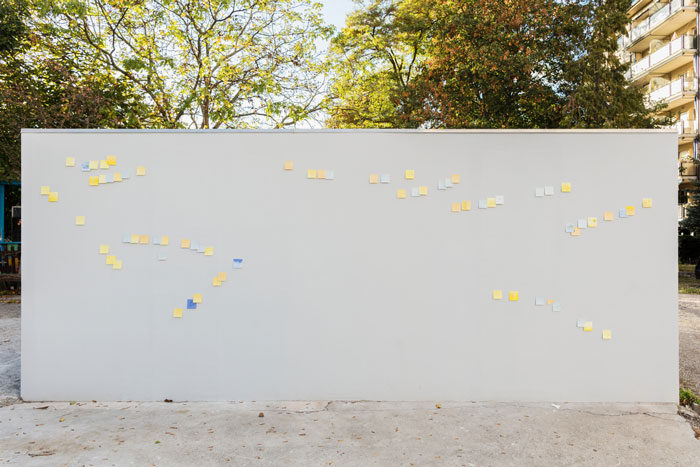
Niels Trannois, La Mue (Singe est nu), 2017-18. © SALTS and Gunnar Meier, 2018
Simon Würsten: In SALTS, your installation is located outdoor, more precisely on the outer walls of the exhibition space. How are these dichotomies of outside and inside, public and private reflected in your installation?
Niels Trannois: The vestibule functions as an interface, a neutral place through which ideas transit, between the domestic space and the public sphere. That’s where thoughts are concentrating, such as, for instance, what not to forget while going out, and what to remember while coming home. It is a social node between two environments. In my installation, it manifests itself in the porcelain sheets. The post-it notes are the mnemonic medium par excellence, where one writes things down in order not to forget them. In the installation, the sheets don’t represent anything particularly “legible,” but a variety of abstract forms that seek to evoke something; they are stamped with objects like a rope, coins or keys—typical elements of transition between a social and a private environment. For the iteration of this work at SALTS, the outside wall plays also the role of a vestibule, as it is located in the courtyard, which is already part of the art space, and the first exhibition “wall” to be encountered.
Simon Würsten: Although in different forms, the topic of memory appears repeatedly in your work. What does it stand for?
Niels Trannois: In this work, I wanted to reactivate a fictional character that’s appearing regularly in my work. Their name is K. J. and they are suffering from Alzheimer’s disease. Few years ago, while doing a family anamnesis, I realized that many of my family members had suffered from this disease, and that I myself was at risk of developing it. Rather than radically altering my lifestyle by fear of increasing the risk, I decided to make this potentiality part of my artistic work. It is so to say, an attempt to consider my own history and to envision my future in a non-linear manner. In this way, Alzheimer’s becomes a driving force within my practice, as it allows me to invert certain logical protocols in painting, and to develop a specific discourse both within the medium and generally speaking. Like the size of the porcelain sheets in the installation, which is referential to the sticky notes as a way for Alzheimer’s patients to remember things.
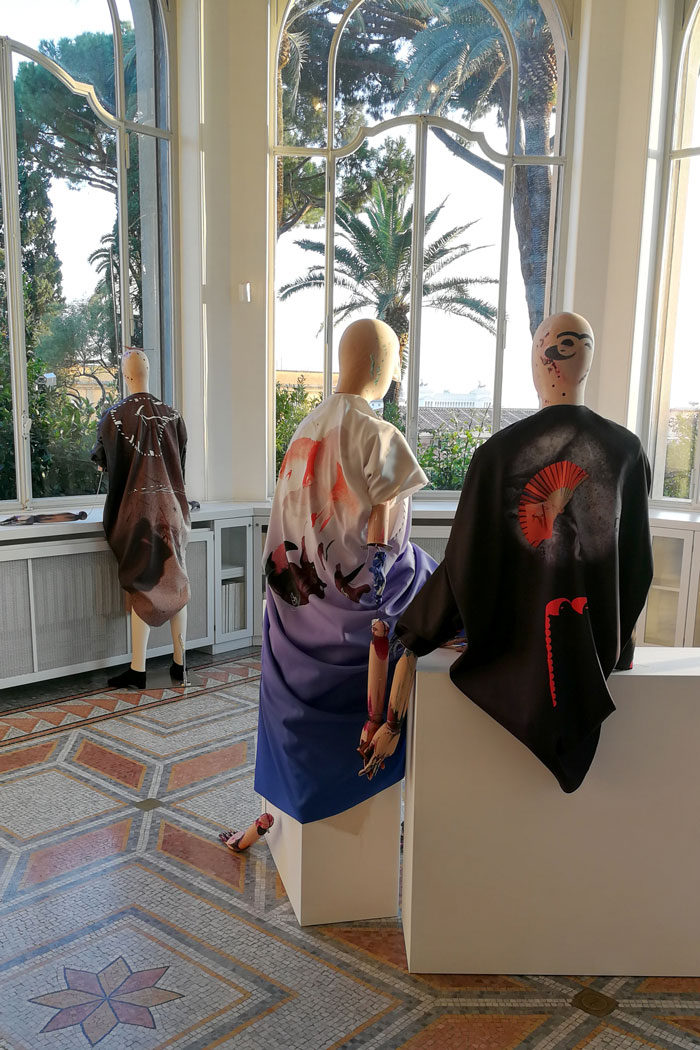
K.A.Y., 2018. Exhibition view Ich, Ich Sehe Dich at Istituto Svizzero, Rome
Simon Würsten: Would you say that this fictional character is an alter ego of yours?
Niels Trannois: Indeed. But not in the sense of an alter ego in the present. Rather, it is a projection of myself in the future, while my artistic work would consist in bringing back to this “future” old and sick fictional me to the present. In my 2017 exhibition K. J. (Lethal Psy Ritual) at Supportico Lopez in Berlin, I had summoned this fictional character in relation to a clear mental image of the Rio Club in Berlin, that had closed some years before. It was a huge domestic space and it had a kind of antechamber that was an interzone with more quiet music, where people could chill, drink and smoke. This room was completely tiled from floor to ceiling. For the exhibition, I created a series of paintings on ceramic tiles and the works became a sort of allegory for all these ephemeral places—clubs, bars, restaurants, reading rooms—that had contributed to build my own mental image of Berlin, where I had lived for 11 years, and was just about to leave. All these environments were formally and symbolically colliding in the paintings.
Simon Würsten: In the case of this project, and generally in your work, I feel like you wish to actively create memories, yet a kind of “anticipated” memories, if you know what I mean, as an expectation of a forthcoming nostalgia or oblivion. At the same time, however, the traces you create are the antithesis of a documentary work, let’s say, through photography for instance. Because instead of trying to render the objective aspect of whatever element you are remembering, it seems that your artworks rather seek to transmit the feeling of memory itself, of the very act of recalling. Something very intimate.
Niels Trannois: It is a good point. At Supportico Lopez, there was a vaguely archeological intention to entrench my inner vision of Berlin, a city that I had seen transform and gentrify over the years. It was a kind of homage. As a matter of fact, this approach towards memory manifests itself in my way of painting through something that I call “sensitive materials,” that is to say the use of fragile, thin, easily marked mediums. For instance when I am using silk from silk screens, although it is literally a photo-sensible material, I don’t use it for its usual reproducible purpose, but as background for some of my paintings. This way of hacking the traditional silk screen process allows me to process an image through a delicate technique, before enhancing or reinterpreting it with a more classical painting gesture. It is a question of capturing an emotional flux, in the same way paint is kept under pressure in a spray can. What I want to convey is the fact that one is never passive when confronting one’s own memories. Moreover, that speaking about one’s own history and memories is simply another way to speak about collective history. The use of porcelain is particularly interesting to that extent: it is a very ancient technique and the material can endure for thousands of years. But if it is badly preserved, it breaks, and the code breaks. It is the same with memory in general: if it is well maintained, then it can be transmitted from generation to generation, but it can also very quickly fall into oblivion. Porcelain is a medium that activates this tension between transmission and the fragility of memories.
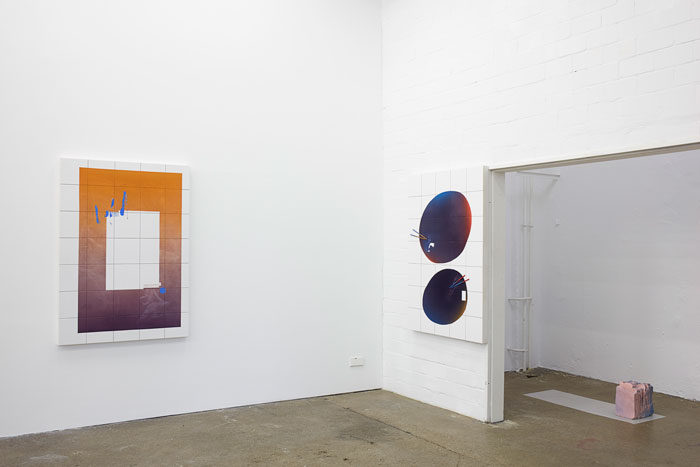
K. J. (Lethal Psy Ritual), 2017. Installation view at Supportico Lopez. Photo by Nick Ash
Simon Würsten: Could you tell me more about the notion of medium in your work? Your practice, while related with painting, is unfolding on a whole range of objects and materials on which you intervene with a variety of techniques, such as porcelain, ceramics, canvas and silk printing. More recently, in the group exhibition Ich, Ich Sehe Dich, that just opened at Istituto Svizzero in Rome, you are presenting wooden dummies dressed in printed clothes. It is as if all these objects were becoming projection surfaces for these memories we were talking about, these emotional fluxes from a particular individual, that somehow become universal through the artistic gesture. So, I am wondering about the function of the act of painting in relation to these objects and references.
Niels Trannois: I am more and more trying to separate the concept of image from that of painting. The notion of the mental image is omnipresent in my work, but it is always mediated through a series of screens, such as in printing. At the end of the process, the mental image becomes a reference, although it is never really visible in the artwork itself. It is smothered by the painting, while emerging through it. As for the medium, it is very contingent on the object that will suit the narrative and the concepts involved in the artwork. It is never predetermined. It is constantly shifting and gets only temporarily solved in an artwork, where both the medium and the painted surface are suddenly correctly balanced. For the paintings I showed in June, in my exhibition at the Fondation Takini in Lyon, for example, I engraved porcelain sheets with erotic drawings initially made on a smartphone during a trip between Naples and Rome, and the rule was to never lift my finger while drawing them. These erotic drawings reappear in the installation at SALTS. After being engraved, the porcelain sheets were fired and the proper painting work came only after that, as a means of binding the image to the medium, to reify or activate the artwork. All in all, painting really acts as a bonding agent that welds together the multiple elements involved in the artwork. It is a way of making visible the different parameters at stake—cultural, emotional and conceptual. And yet, everything always remains suspended in the fine balance achieved through the creative process. I see painting as a way to add a further layer to the whole, and to actually interfere with the original references, somehow like a virus that spreads over the exhibited object and contaminates it.
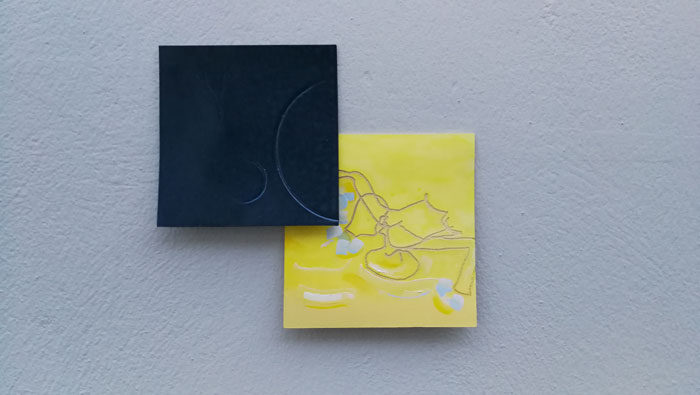
Niels Trannois, La Mue (Singe est nu), 2017-18, detail. © SALTS and Gunnar Meier, 2018
Simon Würsten: You were mentioning the screens that you use to filter the images as a way to maintain them in a state of suspension between mental projection and physical manifestation. I like to see this peculiarity in your pictorial work as a way to codify or encrypt the content of your paintings, which brings me back to the exhibition Hunter of Worlds at SALTS, that explores the notion of language and symbols, that is to say signs that would outlast the extinction of our civilization. In this exhibition, the works you are showing display drawings with a strong symbolical—almost ideographic touch.
Niels Trannois: Exactly. The porcelain “post-its” I present at SALTS reflect my intention to return to some sort of symbolism through my own practice. It’s something that always interested me, and I was fascinated by artists or writers from this movement such as Gustave Moreau, Odilon Redon, Huysmans or even Mallarmé. When thinking about this exhibition I wondered, when considering a language that is irrevocably due to disappear, what mode of communication could transcend this doom and be valid in the future, or even timelessly? I thought about sexuality and the way in which sex is a mode of communication that is eternal, because it is driven by lust—an animal instinct of sorts beyond history and civilizations. I realized that if we were to keep only one mode of communication in the future, then maybe sexuality would be the most valid one. It is a particularly strong way to interact, through penetration, activation of the senses and the creation of a bond between individuals. I like the image of “cum sharing:” I see this practice that consists in coming in someone else’s mouth and for the cum to be passed from mouth to mouth as a very strong metaphor of how sexuality can make interaction between individuals possible, in a codification beyond language, in this case even a genetic code that is being shared and allows reproduction, subsistence and transmission.
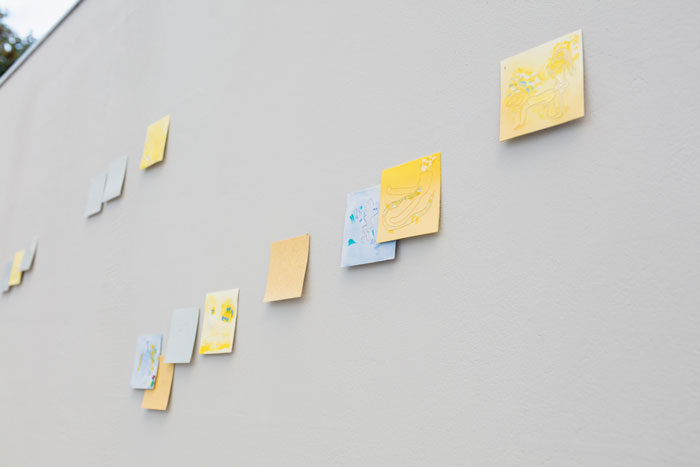
Niels Trannois, La Mue (Singe est nu), 2017-18, detail. © SALTS and Gunnar Meier, 2018
Simon Würsten: There’s a kind of archeological protocol in your creative process, although in an inverted form. While traditional archaeology seeks to give meaning to ancient objects, you create new objects anticipating the ineluctability of a forthcoming semantic void. Archaeology is a way to speculate on the broken link between an artefact that is alien to us and the mental image we have of it in relation to its primitive meaning. In your case, it is like an archaeology, not of the object but of the concept of memory itself, speculating on the very transmission of signs and meaning over time and cultures.
Niels Trannois: Absolutely. I was mentioning earlier Marguerite Duras’s film Les mains négatives. The image shows the subjective vision of a wanderer at dawn through the streets of Paris. It shows workers coming and going, either starting their day or going home after a night at work. In parallel, Duras’s voice-over recounts of a cave, stuck between the cliffs and the ocean, where 30,000 years ago an individual repeatedly created negative prints by blowing black and blue pigments on their hand held against the cave wall. In the text, she implies that the cry of these prints’ author, that records their presence in the cave, reaches us precisely through the traces of this hand, like an echo that resonates until today. The whole substance of the film lies in the gap between this prehistoric cave and the city streets in late 20th century. It is a way to make sense of these images beyond their temporal distance, by invoking them from a subjective point of view.
Simon Würsten: And beyond temporal distance, there is the idea of the semantic sign like a locus, a medium that remains open for each epoch, civilization or individual to project meaning on it; the idea of language as a tool that is never absolute or permanent, but an ambiguous code that is continually recreated by the individual that is confronted to the signs left by their author.
Niels Trannois: It’s exactly why the cultural parameters that inhabit the artworks—and therefore the languages that lie beneath them—can’t be cut off from the origins of the object. History acts like an anchor against the impermanence of things and yet, strangely enough, Alzheimer’s disease could poetically represent a floating key in order to address those semantic signs, a way to expand them further towards other potential meanings.



